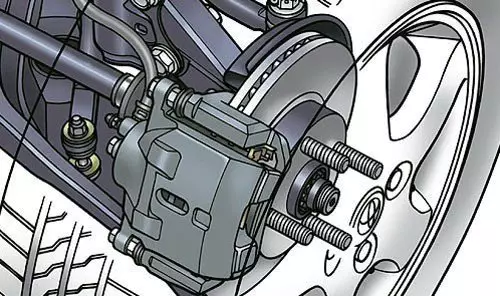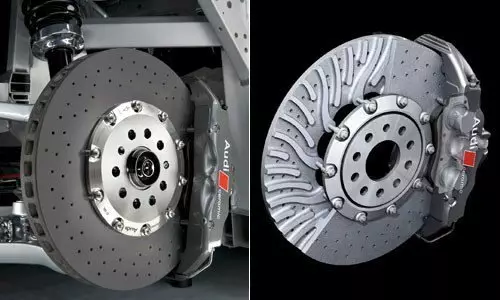The car can run on the road because of the rotation of the wheels. What should I do when the car stops? It is impossible for drivers to stretch their feet to the ground to prevent the car from moving forward like in cartoons. At this time, they have to rely on the brake device on the car to reduce and stop the speed of the car.
Brake: As the name implies, it is a mechanical braking device that can slow down the speed, also known as reducer. Simply put: automotive brake pedal under the steering wheel and press the brake pedal, then the brake lever is linked and pressed to the brake pad on the brake drum to jam the brake roulette wheel, making the car slow down or stop running. The manual brake of the car is next to gear, connected to the brake bar. Bicycle brakes are also common, which are slowed down by rod brakes fixed on the frame or disc-mounted brakes brakes.

The brake system hidden in the wheel is an important device to stop the moving car. The brake device generates friction between the brake pad and pressed roll or disc, and in the process of friction, the kinetic energy of the car is converted into heat energy and consumed. Common brake devices include "drum brake" and "disc brake". Their basic features are as follows:
I. Drum brake:
Two semi-circular brake pads are installed in the wheel hubs, and the brake pads are pushed by the "lever principle" to make the brake pads contact with the inner surface of the pressed roll and friction occurs.
Drum brake has been used in automobiles for nearly a century. However, due to its reliability and strong braking force, drum brake is still configured in many car models (mostly used in rear wheels). Drum brake is to push out the brake pads of the device within brake drum by hydraulic pressure, causing friction between the brake pads and the inner surface of the brake drum with the rotation of the wheel, resulting in the braking effect.
The brake drum inner surface of the drum brake is the position where the brake device generates the brake torque. Under the condition of obtaining the same braking torque, the diameter of brake drum of the drum brake device can be much smaller than that of the disc brake disc. Therefore, in order to obtain strong braking force, heavy-duty large vehicles can only install drum brakes in the limited space of the rim.
The action mode of drum brake
Simply put, drum brake is a brake device that uses static brake pads within brake drum to rub brake drum of the wheel rotation to generate friction to reduce the rotational velocity of the wheel.
When stepping on the brake pedal, the force applied by the foot will cause the piston within the brake master cylinder to push the brake fluid forward and generate pressure in the oil circuit. The pressure is transmitted to the brake fluid piston of each wheel through brake cylinder, and the brake cylinder piston pushes the brake pad outward, causing friction between the brake pad and the inner surface of brake drum, and generating enough friction to reduce the rotation speed of the wheel, in order to achieve the purpose of braking.
Advantages of drum brake
1. It is used for automatic brake tightening, so that brake system can use lower oil pressure or brake drum with a diameter much smaller than brake disc.
2. The installation of handbrake mechanism is easy. Some rear wheel device disc brake models will install drum brake handbrake mechanism in the center of the brake disc.
3. The processing and composition of parts are relatively simple, but they have relatively low manufacturing costs.
Disadvantages of drum brake:
1. The diameter of the brake drum of the drum brake will increase after heating, which will cause the stroke of pressing brake pedal to plus-sized, and the brake reaction will be less than expected. Therefore, when driving a vehicle with drum brakes, we should try our best to avoid the phenomenon of thermal recession caused by high temperature caused by continuous brakes.
2. Brake system the reaction is slow, and the tread of the brake is not easy to control, which is not conducive to high-frequency braking action.
3. There are many complex parts in the structure, and the brake clearance must be adjusted, making maintenance difficult.
Due to the rapid increase of vehicle performance and driving speed, disc brake has become the mainstream of current brake system in order to increase the braking stability of vehicles at high speed. Because the brake disc of the disc brake is exposed to the air, the disc brake has an excellent heat dispersion. When the vehicle brakes urgently at high speed or repeatedly in a short period of time, the performance of the brake is not easy to decline, it can make the vehicle obtain better braking effect, so as to enhance the safety of the vehicle.
And because of the fast response of disc brake and its ability to do high-frequency brake action, many car models use disc brake to match with ABS system, VSC, TCS and other systems, to meet the needs of such systems for quick operation.
II. Disc brake:
Use brake caliper to control two brake pads to clamp the brake disc on the wheel. When the brake pads hold disc, friction will occur between them.

The brake discs used for high-performance sports car are mostly perforated ventilation plate, which has good cooling effect.

Cold air passes through the wheel to cool the brake disc.
Function mode of disc brake:
As the name implies, disc brake uses static brake disc to clamp the brake disc rotating with the tire to generate friction, making the wheel rotational velocity lower the brake device.
When the brake pedal is pressed, the piston within brake master cylinder will be pushed, and the pressure will be established in the brake fluid Road. The pressure is transmitted to the piston of brake fluid on the brake caliper through brake cylinder. After the piston of brake cylinder is under pressure, it will move outward and push the brake pad to clamp the brake disc, causing friction between the brake pad and the brake disc, to reduce the wheel speed, so that the car can slow down or stop.
Advantages of disc brake:
1. Disc brake heat dispersion is better than drum brake, and it will not cause brake recession and brake failure when stepping on the brake continuously.
2. The change of the size of the brake disc after heating does not increase the stroke of the brake pedal.
3. The disc brake system responds quickly and can be used for high frequency braking action, so it is more in line with the requirements of ABS system.
4. Disc brake does not have the automatic tightening effect of drum brake, so the braking force of left and right wheels is relatively average.
5. Due to the better drainage of the brake disc, the situation of poor braking caused by water or sediment can be reduced.
6. Compared with drum brake, disc brake has simple structure and easy maintenance.
Disadvantages of disc brake:
1. Because there is no automatic tightening effect of drum brake, the braking force of disc brake is lower than that of drum brake.
2. The friction area between the brake pad of disc brake and the brake disc is smaller than that of drum brake, which makes the brake force smaller.
3. In order to improve the disadvantages of the above disc brake, a larger stepping force or oil pressure is needed. Therefore, it is necessary to use a brake disc with a larger diameter or increase the oil pressure by brake system to improve the braking force.
4. Handbrake the device is not easy to install, and some rear wheels use disc brakes to add a group of drum brake handbrake mechanism for this purpose.
5. The wear of brake pads is relatively large, and the replacement frequency may be relatively high.